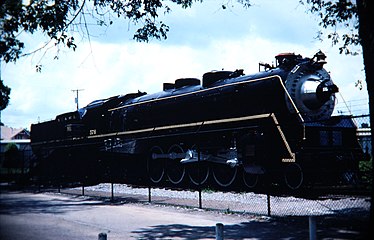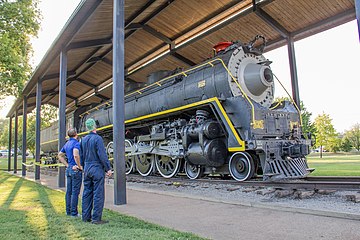railroad.wikisort.org - Train
Nashville, Chattanooga and St. Louis 576 is a 4-8-4 "Dixie" (Northern) type steam locomotive built in August 1942 by the American Locomotive Company (ALCO) of Schenectady, New York for the Nashville, Chattanooga and St. Louis Railway (NC&StL) as a member of the J-3 class. Designed with some of the latest locomotive technological features of the time, the J3 class was used to handle heavy freight and express trains to aid the American war effort during World War II.
| Nashville, Chattanooga and St. Louis 576 | |||||||||||||||||||||||||||||||||||||||||
|---|---|---|---|---|---|---|---|---|---|---|---|---|---|---|---|---|---|---|---|---|---|---|---|---|---|---|---|---|---|---|---|---|---|---|---|---|---|---|---|---|---|
 NC&StL No. 576 on static display at the Centennial Park in December 2008 | |||||||||||||||||||||||||||||||||||||||||
| |||||||||||||||||||||||||||||||||||||||||
| |||||||||||||||||||||||||||||||||||||||||
| |||||||||||||||||||||||||||||||||||||||||
| |||||||||||||||||||||||||||||||||||||||||
Faced with dwindling traffic and the onset of dieselization, all of the J3s were withdrawn from service and scrapped by September 2, 1952 with the exception of No. 576. In September 1953, the locomotive was donated to the City of Nashville, Tennessee and placed on static display at the Centennial Park as the sole surviving steam locomotive of the NC&StL Railway.
The No. 576 locomotive is currently being restored to operating condition by the Nashville Steam Preservation Society (N.S.P.S) for use in excursion service on the Nashville and Eastern Railroad and the restoration work was expected to be completed by 2024.
History
Design and appearance
During the outbreak of World War II, the Nashville, Chattanooga and St. Louis Railway (NC&StL) were unable to order more diesel locomotives for the increased passenger train traffic.[1] They decided to go for steam power with the American Locomotive Company (ALCO) proposing a streamlined 4-8-4 J3 locomotive similar to the Norfolk and Western J class locomotives, but was rejected by the Louisville and Nashville Railroad (L&N) due to the expensive design cost.[1]
The NC&StL's Superintendent of Machinery, Clarence M. Darden designed ten J3 (Nos. 570-579) locomotives delivered between July and August 1942 from ALCO in a non-streamlined design with yellow skirting panels, a bullet nose cone, boxpok drivers, and a large semi-Vanderbilt tender holding 16 tonnes (16,000 kg) of coal and 15,000 US gallons (57,000 l) of water.[1] Because of the J3s' appearance, the NC&StL crews nicknamed them as the Yellow Jackets.[1] In 1943, ALCO built ten more J3s (Nos. 580-589) without the yellow skirting panels due to wartime restrictions so their running board edges were painted yellow, giving them the nickname Stripes.[3] The same treatment was given to the 1942 J3 locomotives when their yellow skirting panels were removed in 1947 for easier maintenance and even the bullet nose cones were removed on all of the J3s.[1] As opposed to the 4-8-4s nicknamed the Northerns, the J3s were nicknamed the Dixies by the NC&StL.[1]
Revenue service and retirement
No. 576 was built at a cost of $166,500 and delivered to the NC&StL Railway, where it entered revenue service on August 18, 1942.[2] No. 576 and the other J3s handled the critical war-time material, armament and troop train movements during the rabid buildup and mobilization of the American war effort during World War II.[1] They were only assigned to run between Nashville and Chattanooga, Tennessee due to the turntable limitations in Atlanta, Georgia until the 110-feet turntables were eventually installed for the J3s to be turned around in Atlanta.[1] When the war ended in 1945, the J3s were reassigned to dual freight and passenger service.[4]
As the NC&StL began to dieselize, all of the J3s were retired and scrapped between 1951 and 1952, with the exception of No. 576, which was chosen for preservation and subsequently donated to the City of Nashville to be put on static display at the Centennial Park in September 1953.[2] In 2004, a shelter shed was built over the No. 576 locomotive to prevent it from being exposed to the elements.[5]
Restoration
In April 2016, the newly formed Nashville Steam Preservation Society (NSPS) made plans to restore No. 576 to operating condition for excursion service.[2][6] In October 2018, the N.S.P.S. had successfully raised the necessary $500,000 to relocate and transport the locomotive out of the park and into a nearby restoration facility.[7]
On January 13, 2019, the locomotive was moved out of the Centennial Park and on to Nashville and Western trackage, where it was prepared to move from the line to CSX and beyond to the Nashville and Eastern Railroad where it would be restored to operating condition.[8][9] The locomotive made a final public appearance at Nashville Union Station Hotel on March 9, 2019 and the next day, moved to the Tennessee Central Railway Museum's workshop where the restoration work on No. 576 begin.[10][11] During the restoration work, a new cab was fabricated from scratch due to the locomotive's original cab being deteriorated beyond repair.[12]
In March 2021, a storm struck the city of Nashville and the workshop where No. 576 was stored became severely damaged as a result.[13] The locomotive was undamaged with the workshop rebuilt shortly after and the restoration work has resumed.[14] On April 15, Trains Magazine went into partnership with the NSPS to launch the 'Steam the Stripe' campaign in an effort to raise $600,000 for the No. 576 locomotive's drivers and trucks to be renovated, and the locomotive's boiler to be hydrostatically tested.[15]
On June 17, 2021, No. 576's boiler and frame have been lifted up from its wheels and running gear for them to be repaired.[16] The driving wheels were sent to be repaired at the Tennessee Valley Railroad Museum in Chattanooga, Tennessee.[16] The restoration work of No. 576 is expected to be completed around 2024.[17]
Gallery
- No. 576 on static display at the Centennial Park in May 1982
- No. 576 being repainted prior to the first Open House hosted by the Nashville Steam Preservation Society to promote and fundraise its restoration
See also
- Norfolk and Western 611
- Southern Pacific 4449
- Union Pacific 844
- Grand Trunk Western 6325
- Reading 2101
- Reading 2102
- Chesapeake and Ohio 614
- Santa Fe 3751
- Spokane, Portland and Seattle 700
References
- Morgan, David P. (1963). "Gliders, Yellow Jackets, and Stripes". Nashville Steam Preservation Society. Archived from the original on January 23, 2021. Retrieved June 19, 2021.
- Ibata, David (April 26, 2016). "Team to restore a 'Dixie' 4-8-4". Trains. Kalmbach Media. Archived from the original on February 11, 2021. Retrieved June 19, 2021.
- Drury (2015), p. 228.
- "A Brief History Of #576". NC&StL Preservation Society. Archived from the original on February 11, 2021. Retrieved January 9, 2022.
- Moriarty, Megan (January 30, 2004). "Park Train To Get Protection". The Nashville City Paper. Archived from the original on July 26, 2008. Retrieved January 13, 2022.
- Wrinn, Jim (April 15, 2016). "NC&StL No. 576 Proposed Restoration Announcement". Nashville Steam Preservation Society. Archived from the original on November 26, 2020. Retrieved June 19, 2021.
- Bryan, Joey (October 11, 2018). "NSPS Steam Reaches Initial Fundraising Goal". Nashville Steam Preservation Society. Archived from the original on January 23, 2021. Retrieved June 19, 2021.
- Bryan, Joey (December 13, 2018). "No. 576 to Leave Centennial Park on January 13th!". Nashville Steam Preservation Society. Archived from the original on January 23, 2021. Retrieved June 19, 2021.
- Koehn, Alexandra (January 13, 2019). "A steam train built in the 40's is on its way to restoration". WTVF. Archived from the original on December 2, 2020. Retrieved June 21, 2021.
- Hilt, Eric (March 10, 2019). "Locomotive No. 576 moves to old home". WTVF. Archived from the original on June 21, 2021. Retrieved June 21, 2021.
- "Historic steam train arrives at Nashville museum for restoration". WKRN-TV. March 11, 2019. Archived from the original on March 3, 2021. Retrieved June 21, 2021.
- Bryan, Joey (March 2021). "Nashville Steam Preservation Society - NSPS - 576 Update" (PDF). The Order Board. Vol. 41, no. 3. Tennessee Central Railway Museum. p. 8. Archived from the original (PDF) on January 11, 2022. Retrieved January 11, 2022.
- Overdeep, Meghan (March 30, 2021). "Steam Shop Restoring Historic Nashville Train Suffers Serious Damage in Storm". Southern Living. Archived from the original on March 31, 2021. Retrieved June 17, 2021.
- Nolan, Davis (April 21, 2021). "Restoration of Old Locomotive 576 resumes after March storm damage". WKRN-TV. Archived from the original on April 26, 2021. Retrieved June 21, 2021.
- Bryan, Joey (April 15, 2021). "Trains Magazine Announces Nashville Steam as the Next Preservation Partner". Nashville Steam Preservation Society. Archived from the original on June 27, 2021. Retrieved May 2, 2022.
- Bryan, Joey (June 17, 2021). "NSPS Completes Engine Lift and Wheel Removal". Nashville Steam Preservation Society. Archived from the original on June 20, 2021. Retrieved June 20, 2021.
- Freeman, WaTeasa (June 18, 2021). "Progress continues to restore former Centennial Park locomotive to operation". The Tennessean. Retrieved January 13, 2022.
Bibliography
- Drury, George H. (2015). Guide to North American Steam Locomotives (2nd ed.). Kalmbach Media. ISBN 978-1-62700-259-2.
Further reading
- Prince, Richard E. (2001). Nashville, Chattanooga & St. Louis Railway: History and Steam Locomotives (2nd ed.). Indiana University Press. ISBN 978-0-253-33927-0.
External links
- Nashville Steam Preservation Society
- Nashville Steam on Facebook
Другой контент может иметь иную лицензию. Перед использованием материалов сайта WikiSort.org внимательно изучите правила лицензирования конкретных элементов наполнения сайта.
WikiSort.org - проект по пересортировке и дополнению контента Википедии

